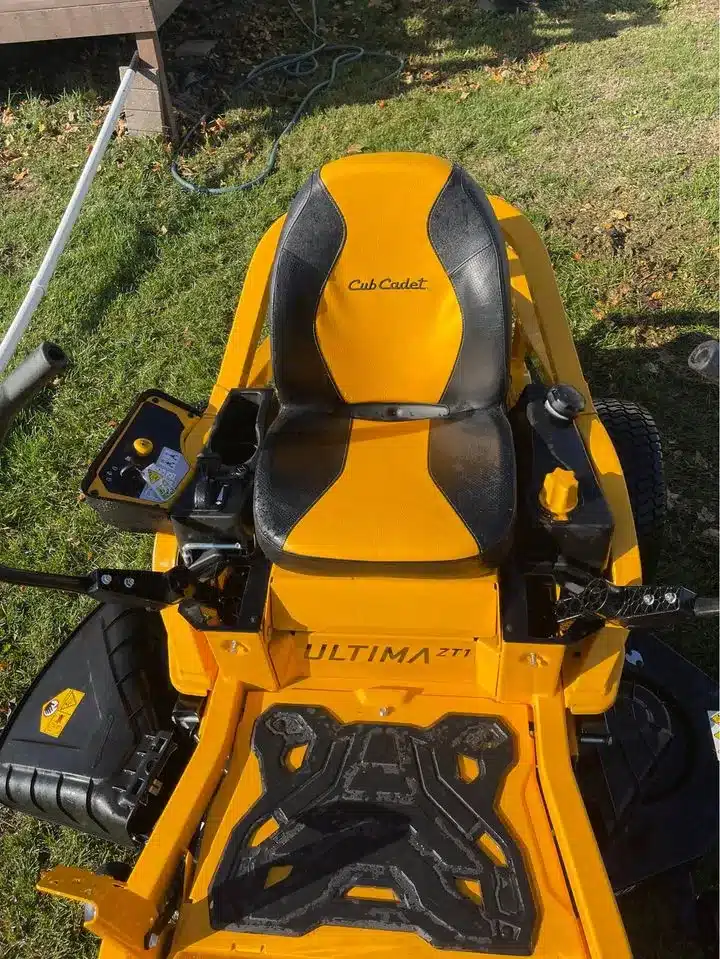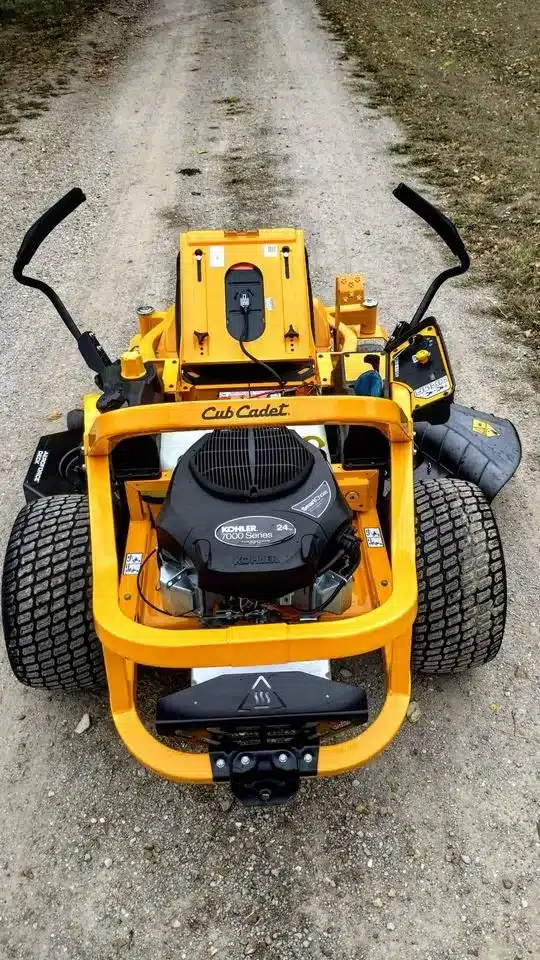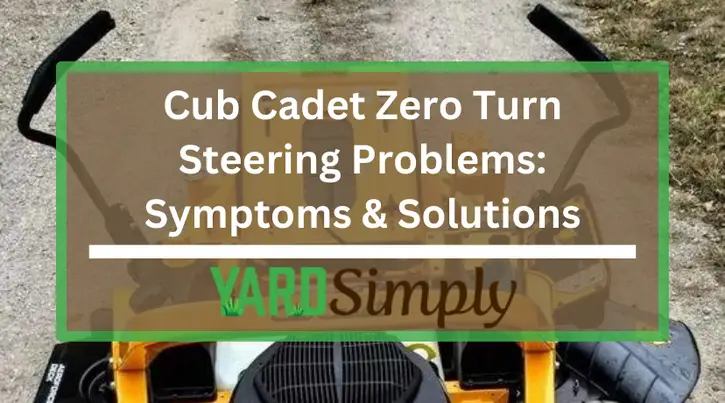As a seasoned landscaper with extensive experience in maintaining and repairing lawn mowers, I understand the complexities of Cub Cadet zero turn mowers and their steering systems.
Steering problems can significantly impact your mower’s performance, and I’m here to provide you with the practical knowledge needed to identify and fix these issues efficiently.
Trust in my hands-on expertise to guide you through resolving the steering challenges that may arise with your Cub Cadet, ensuring you can return to seamless lawn maintenance.
Quick Summary
- Common steering problems in Cub Cadet zero turn mowers include difficulty turning the steering wheel, loose steering, misaligned steering arms, power steering issues, and steering vibration, which require appropriate troubleshooting and repairs.
- Regular lubrication, clearing debris, and replacing worn parts are essential for maintaining the steering system’s smooth operation.
- Timely maintenance can prevent up to 50% of common lawn mower steering problems, emphasizing the importance of regular upkeep.
- In my experience, seeking professional help for complex steering issues can save time and money, ensuring optimal mower performance.
Cub Cadet Steering Problems, Symptoms, and Solutions
I’ve noticed my Cub Cadet’s steering feels off lately, and it’s a common issue many owners encounter.
From struggling to turn the wheel to dealing with a wobbly steering column, these problems can really impact the mower’s performance.
Let’s tackle the symptoms head-on and explore the fixes that can get us back to smooth maneuvering.
Related Articles:
Problem-1: Hard to Turn the Steering Wheel
A common issue encountered with Cub Cadet zero turn mowers is difficulty in turning the steering wheel, which may signal a problem in the steering mechanism. This can be particularly challenging during mowing, where tight maneuverability is crucial.
Symptoms:
- The steering wheel is hard to turn.
- This issue primarily arises during mowing, impacting the mower’s maneuverability.
Possible Causes and How the System Operates:
The steering difficulty could be due to several factors within the mower’s steering system:
- Lack of Lubrication: The steering mechanism requires regular lubrication to function smoothly. If it’s not adequately lubricated, the steering wheel can become stiff and difficult to turn.
- Debris Buildup: Debris like dirt and grass can accumulate in the steering components, hindering movement and making the steering wheel hard to turn.
- Wear and Tear: Over time, the steering gears or the steering column might wear out or get damaged, affecting the steering mechanism’s effectiveness.
The steering mechanism of a Cub Cadet zero turn mower operates by transmitting the driver’s input through a network of gears and linkages.
When you turn the steering wheel, this movement is transferred through these components, ultimately directing the mower’s wheels.
Proper operation and responsiveness of this system depend on the integrity and smooth functioning of its parts.
Troubleshooting and Solutions:
- Regular Maintenance: Consistent maintenance of the steering system is crucial. It involves checking the entire mechanism for any signs of wear or damage.
- Clearing Obstructions: Inspect the steering components for any buildup of debris and clear them out. This helps in ensuring that the parts can move freely without any hindrance.
- Lubrication: Apply suitable lubricants to the steering mechanism. Focus on areas like ball joints and grease fittings, as specified in the user manual. This not only eases the movement but also prolongs the life of the components.
- Inspect Wear and Tear: Examine the steering gears and steering column for any signs of wear or damage. Pay attention to the ball joints, tie rods, steering arms, and other relevant parts.
- Part Replacement: If during inspection, any worn or damaged parts are identified, they should be promptly replaced. This is crucial to prevent further problems and ensure safe operation.
Problem-2: Loose Steering Wheel
Loose or imprecise steering in Cub Cadet zero turn mowers is often attributable to wear and tear in the steering components or issues with the steering linkage.
This problem can lead to uneven cutting paths and a potential loss of control, which are significant concerns for both safety and lawn quality.
Symptoms:
- The steering feels loose or imprecise.
- This can result in uneven cutting paths and a loss of control over the lawnmower.
Possible Causes and How the System Operates:
- Wear and Tear in Steering Components: The steering system is comprised of various components, such as gears, linkages, and joints, which can wear out over time. This wear and tear can lead to a decrease in the tightness and precision of the steering.
- Issues with the Steering Linkage: The steering linkage, which connects the steering wheel to the mower’s wheels, is crucial for accurate steering. Problems here, such as loosened connections or damaged parts, can significantly affect the steering’s responsiveness.
The steering system of a Cub Cadet zero turn mower operates through a network of mechanical linkages and joints.
When these components are in good condition, they work together to translate the steering wheel’s movements into precise movements of the mower’s wheels.
Over time, however, these parts can become worn or loose, leading to less precise steering control.
Troubleshooting and Solutions:
- Inspecting Steering Gear and Linkage: Thoroughly check the steering gear and linkage for any signs of play, slack, or wear. This involves examining the connections and the condition of each component.
- Tightening Loose Components: If any components within the steering system are found to be loose, they should be tightened securely. This can restore the system’s integrity and improve steering precision.
- Replacing Worn or Damaged Parts: In cases where parts of the steering system are worn out or damaged, they need to be replaced. Using the correct replacement parts is crucial for maintaining the functionality and safety of the mower.
- Regular Maintenance: Regular maintenance of the steering system can prevent many issues. This includes checking and tightening components as part of routine upkeep and being vigilant for any signs of wear or damage.
- Professional Consultation: If you are unsure about diagnosing or fixing the issue, consulting a professional is advisable. A skilled technician can accurately identify the problem and perform necessary repairs, ensuring the mower’s safe operation.
Problem-3: Misaligned Cub Cadet Steering Arms

Misaligned steering arms in Cub Cadet zero turn mowers are a frequent issue that can significantly affect the accuracy of your mowing path, leading to uneven and erratic movement.
Symptoms:
- The steering arms on the mower are misaligned.
- The mower veers off course, causing uneven and erratic movements.
Possible Causes and How the System Operates:
- Steering Arms Not Parallel: The steering arms, which connect the steering mechanism to the wheels, must be parallel for accurate steering. If they are misaligned, it can disrupt the mower’s ability to follow a straight path.
- Impact of Misalignment: Misaligned steering arms disrupt the mower’s balance and ability to move in a straight line, leading to uneven lawn cuts and inefficient mowing.
The steering mechanism in Cub Cadet zero turn mowers relies on the precise alignment of its steering arms for accurate direction control. These arms play a critical role in transferring the steering inputs to the mower’s wheels.
If they are not correctly aligned, it can lead to a loss of control and precision in the mower’s path.
Troubleshooting and Solutions:
- Adjusting the Steering Arms: The first step in correcting misalignment is to adjust the steering arms. This involves loosening the bolts that hold the arms in place, carefully repositioning them to ensure they are parallel, and then securely tightening the bolts again.
- Precision and Patience in Adjustment: Properly aligning the steering arms requires patience and precision. It’s essential to make sure that both arms are equally adjusted to ensure balanced steering.
- Checking Alignment Post-Adjustment: After adjusting the arms, it’s important to check the alignment. This can be done by observing the mower’s path on a flat surface to ensure it moves in a straight line without veering off course.
- Regular Maintenance Checks: Regularly inspecting the steering arms as part of routine mower maintenance can help catch and correct misalignment issues early, before they become more pronounced.
- Seeking Professional Assistance: If you are unsure about adjusting the steering arms yourself, it is advisable to seek professional help. A trained technician can ensure the adjustments are done correctly, which is crucial for the mower’s safety and performance.
Problem-4: Power steering problems
Power steering issues in Cub Cadet zero turn mowers can make navigating through tight turns and around obstacles challenging.
These problems often manifest as difficulty in turning the steering wheel, slower response times, and a general feeling of struggling with the machine.
Symptoms:
- Difficulty turning the steering wheel.
- Slower response in maneuvering, especially around turns and obstacles.
- The feeling of wrestling with the mower rather than smoothly controlling it.
Possible Causes and How the System Operates:
- Low Power Steering Fluid: The power steering system relies on hydraulic fluid to operate smoothly. If the fluid level is low, it can lead to a decrease in steering efficiency and responsiveness.
- Leaks in the Power Steering System: Leaks within the system can lead to a drop in fluid levels, which in turn affects the power steering’s performance. These leaks can occur along the lines or around the pump.
The power steering system in Cub Cadet mowers is designed to facilitate easy and responsive steering control. It uses hydraulic pressure to assist in the steering process, which significantly reduces the effort needed to turn the wheels.
When this system is compromised, due to either low fluid levels or leaks, it loses its efficiency, leading to the issues mentioned above.
Troubleshooting and Solutions:
- Checking and Topping Off Fluid Levels: Regularly check the power steering fluid level and top it off if it’s found to be low. It’s important to use the type of fluid recommended by Cub Cadet for optimal performance.
- Inspecting for Leaks: Thoroughly inspect the power steering system for any signs of leaks. Pay particular attention to the hydraulic lines and the area around the pump. Any discovered leaks should be addressed promptly.
- Regular Maintenance: Incorporate checking the power steering system into your regular mower maintenance routine. This helps in early detection of potential issues.
- Professional Assistance: If you’re not comfortable checking or repairing the power steering system yourself, or if the issue persists after your attempts to fix it, it’s advisable to seek professional help. A qualified technician can diagnose and repair more complex issues more effectively.
Problem-5: Vibration in the Steering
Vibration in the steering of Cub Cadet zero turn mowers is not only a nuisance but could also be indicative of more significant underlying issues in the mower’s steering system.
Symptoms:
- Notable vibration felt in the steering while operating the mower.
- The presence of this vibration could point to deeper problems within the steering mechanism.
Possible Causes and How the System Operates:
- Worn-Out Steering Components: Over time, components within the steering mechanism, such as the steering shaft and its bearings, can wear out. This wear can lead to looseness or imbalance in the steering system, resulting in vibrations.
- Wheel Imbalance: The balance of the mower’s wheels is crucial for smooth operation. Imbalances in the wheels can transfer uneven forces to the steering mechanism, causing vibrations.
The steering system in Cub Cadet mowers is designed to provide a smooth and responsive steering experience. It consists of various interconnected components that must work harmoniously.
When these components are in good condition, vibrations are minimal. However, wear and tear or imbalances can disrupt this harmony, leading to noticeable vibrations.
Troubleshooting and Solutions:
- Inspecting the Steering Shaft and Bearings: Check the steering shaft and its bearings for any signs of wear or damage. Worn or damaged parts here can be a primary source of vibration and should be replaced if necessary.
- Balancing the Wheels: Ensure that the wheels are correctly balanced. Unbalanced wheels can cause the entire mower to shake, which can be felt in the steering. This might involve checking the tire pressure and the condition of the tires themselves.
- Regular Maintenance: Include the inspection of steering components and wheel balance in your regular maintenance routine. This proactive approach can help identify and rectify issues before they escalate.
- Consult a Professional: If the vibration persists despite your efforts, or if you are unsure how to proceed with the inspection and repairs, it’s advisable to consult a professional. A skilled technician can accurately diagnose the cause of the vibration and suggest appropriate solutions.
Essential Guide to Cub Cadet Zero Turn Steering System Maintenance

Maintaining the steering components of your Cub Cadet zero turn mower is crucial for ensuring optimal performance and longevity. Here is a maintenance schedule specifically focused on the steering system:
Regular Maintenance (Before Each Use):
- Inspect Steering System: Check for any loose components, such as bolts or nuts, in the steering mechanism.
- Check for Steering Smoothness: Ensure the steering wheel or levers operate smoothly without any stiffness or unusual resistance.
Every 25 Hours:
- Lubricate Steering Components: Apply suitable lubricants to pivotal steering parts such as ball joints and linkage connections. Use the lubricant recommended by Cub Cadet.
- Check for Wear and Tear: Inspect steering gears, linkages, and arms for any signs of wear or damage.
Every 50 Hours:
- Tighten Loose Components: Secure any loose bolts or nuts in the steering mechanism. This includes checking the tightness of the steering wheel, if applicable.
- Inspect Steering Linkage: Ensure that the linkage connecting the steering to the wheels is intact and functioning properly.
Every 100 Hours:
- Deep Inspection of Steering System: Conduct a thorough inspection of all steering components, including tie rods, steering shaft, and bearings.
- Replace Worn Parts: If any steering components are worn out or damaged, replace them with suitable parts as recommended by Cub Cadet.
Seasonal Maintenance (or Annually):
- Comprehensive Steering System Check: Before the mowing season, give the entire steering system a comprehensive check to ensure everything is in top condition.
- Check Wheel Alignment: Ensure the wheels are properly aligned, as misaligned wheels can cause steering issues.
As Needed:
- Respond to Issues Promptly: If you notice any irregularities in steering, such as vibrations or difficulty in turning the wheel, address these issues immediately to prevent further damage.
Additional Tips:
- Keep It Clean: Regularly clean the mower, focusing on removing debris from steering components.
- Refer to the Manual: Always refer to your Cub Cadet operator’s manual for detailed procedures and any model-specific instructions.
- Seek Professional Help if Needed: If you are unsure about any aspect of the steering system maintenance, consult a professional or take your mower to a local service dealer.
Our Verdict
After delving into the common steering problems of your favorite Cub Cadet zero turn mowers and exploring their solutions, I feel more equipped to handle these challenges in my own landscaping work.
From stiff controls to misaligned steering arms, I’ve realized the importance of regular maintenance and prompt repairs.
In my experience, addressing these issues not only enhances the mower’s performance but also makes my mowing sessions more enjoyable.
I’ve learned that taking proactive steps, like checking steering components and keeping them lubricated, can prevent many of these problems. Plus, knowing when to seek professional help has saved me time and money.
Remember, a well-maintained mower leads to a beautifully groomed lawn, and that’s always my ultimate goal.
Frequently Asked Questions
How does the warranty of my Cub Cadet zero turn mower cover steering-related issues?
I need to check my warranty to see if it includes coverage for steering issues on my mower. It’s best to consult the terms or contact customer service for specific details.
Can steering problems with a Cub Cadet zero turn mower indicate an underlying issue with the transmission system?
Steering issues in my mower might suggest transmission troubles, but it’s not always the case. I’ll need to check for other signs or consult a professional to be sure of the root cause.
Are there any DIY calibration techniques for the steering system of a Cub Cadet zero turn mower that won’t void my warranty?
I’m looking for DIY calibration techniques for my mower’s steering system that won’t void the warranty. I’ll check the manual and perhaps contact customer service for guidance to avoid any missteps.
What are some maintenance best practices to prevent future steering problems in Cub Cadet zero turn mowers?
I regularly check tire pressure, lubricate moving parts, and inspect belts for wear to maintain my mower. Sticking to the service schedule and keeping components clean also helps prevent future issues.
How does terrain and lawn condition affect the steering performance of a Cub Cadet zero turn mower over time?
Rough terrain and poor lawn conditions can wear down my mower’s steering components over time, leading to less responsive handling and increased maintenance needs for optimal performance.


